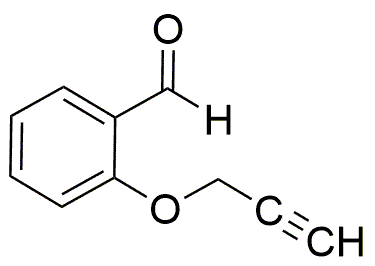2-(Prop-2-yn-1-yloxy)benzaldehyde is widely utilized in research focused on:
- Synthesis of Fine Chemicals: This compound serves as an important intermediate in the synthesis of various fine chemicals, including pharmaceuticals and agrochemicals, due to its unique reactive properties.
- Organic Synthesis: It is commonly used in organic synthesis reactions, particularly in the formation of complex molecules, making it valuable for researchers in the fields of medicinal chemistry and materials science.
- Fluorescent Probes: The compound can be employed in the development of fluorescent probes, which are essential in biological imaging and diagnostics, enhancing visibility and specificity in research applications.
- Polymer Chemistry: It finds applications in polymer chemistry, where it can be used to modify polymer properties, leading to materials with enhanced performance in industries such as packaging and coatings.
- Research on Antimicrobial Agents: Researchers are exploring its potential as a precursor for antimicrobial agents, contributing to the development of new treatments in the pharmaceutical industry.
General Information
Properties
Safety and Regulations
Applications
2-(Prop-2-yn-1-yloxy)benzaldehyde is widely utilized in research focused on:
- Synthesis of Fine Chemicals: This compound serves as an important intermediate in the synthesis of various fine chemicals, including pharmaceuticals and agrochemicals, due to its unique reactive properties.
- Organic Synthesis: It is commonly used in organic synthesis reactions, particularly in the formation of complex molecules, making it valuable for researchers in the fields of medicinal chemistry and materials science.
- Fluorescent Probes: The compound can be employed in the development of fluorescent probes, which are essential in biological imaging and diagnostics, enhancing visibility and specificity in research applications.
- Polymer Chemistry: It finds applications in polymer chemistry, where it can be used to modify polymer properties, leading to materials with enhanced performance in industries such as packaging and coatings.
- Research on Antimicrobial Agents: Researchers are exploring its potential as a precursor for antimicrobial agents, contributing to the development of new treatments in the pharmaceutical industry.
Documents
Safety Data Sheets (SDS)
The SDS provides comprehensive safety information on handling, storage, and disposal of the product.
Product Specification (PS)
The PS provides a comprehensive breakdown of the product’s properties, including chemical composition, physical state, purity, and storage requirements. It also details acceptable quality ranges and the product's intended applications.
Certificates of Analysis (COA)
Search for Certificates of Analysis (COA) by entering the products Lot Number. Lot and Batch Numbers can be found on a product’s label following the words ‘Lot’ or ‘Batch’.
*Catalog Number
*Lot Number
Certificates Of Origin (COO)
This COO confirms the country where the product was manufactured, and also details the materials and components used in it and whether it is derived from natural, synthetic, or other specific sources. This certificate may be required for customs, trade, and regulatory compliance.
*Catalog Number
*Lot Number
Safety Data Sheets (SDS)
The SDS provides comprehensive safety information on handling, storage, and disposal of the product.
DownloadProduct Specification (PS)
The PS provides a comprehensive breakdown of the product’s properties, including chemical composition, physical state, purity, and storage requirements. It also details acceptable quality ranges and the product's intended applications.
DownloadCertificates of Analysis (COA)
Search for Certificates of Analysis (COA) by entering the products Lot Number. Lot and Batch Numbers can be found on a product’s label following the words ‘Lot’ or ‘Batch’.
*Catalog Number
*Lot Number
Certificates Of Origin (COO)
This COO confirms the country where the product was manufactured, and also details the materials and components used in it and whether it is derived from natural, synthetic, or other specific sources. This certificate may be required for customs, trade, and regulatory compliance.


